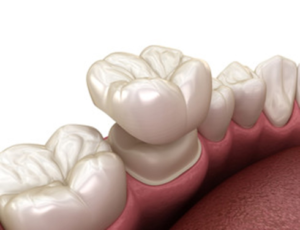
Smiling is universal—people everywhere use their pearly whites to convey joy, confidence, and good health! And thanks to modern dentistry, everyone has access to a brighter, whither, and more functional smile. One such treatment that patients rely on is dental crowns; they can be used to restore a damaged, decayed, or otherwise compromised tooth with ease in terms of both functionality and appearance. But how do dentists go about color-matching these nifty restorations to the rest of your natural teeth? Keep reading to learn more!
What Are Dental Crowns?
A dental crown is a cap that a dentist places over the tooth in order to provide it with an immense level of protection. This treatment may be necessary if a patient’s tooth has become worn down due to damage, or if there’s a cavity that is too large to fill. It’s also the go-to treatment following a root canal. Crowns can also cover up discolored or otherwise unsightly teeth. Essentially, they’re one of the most versatile restorative treatments in modern dentistry.
What Colors Are Dental Crowns?
Dental crowns come in a variety of materials, which means there are a few different options for the color. Traditionally, crowns were often made from metals such as gold, chromium, nickel, and others—this amalgam was silver-gray in appearance and quite unnatural-looking, though reliable. These days, materials such as porcelain and ceramic are used, which can be color-matched to the surrounding teeth; in fact, these options aren’t even identifiable to the untrained eye!
How Are Crowns Color-Matched?
There are a few main methods used by dentists to color-match crowns to a patient’s natural teeth. The dentist may use a shade guide, which has a collection of tooth-colored tabs that can be used to determine the exact shade of the teeth. Digital tools and software can also be used to capture high-resolution images of teeth, making it easier to identify their subtle color variations. The dentist will also ask the patient for their opinion, since color matching can be quite subjective!
Funnily enough, there are other factors that can influence the color-matching process. For instance, your dentist will examine your teeth under different types of lighting conditions, to ensure that the chosen shade looks natural under various circumstances. If a patient is wearing something brightly colored, they might be asked to remove it since it can cause unfavorable contrast.
About the Author
Dr. Olga Kandov received her DMD from Temple University’s Maurice H. Kornberg School of Dentistry and has proudly served patients and families in the Doylestown, PA community for several years. Her practice is thrilled to offer a wide range of services including restorative options like dental crowns. If you have any questions about the blog or her practice, or you’d like to schedule a visit, feel free to contact her through her website or by phone: (215) 798-5472.